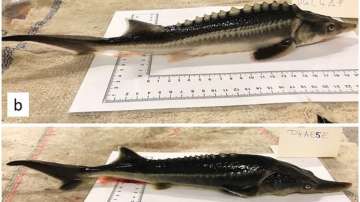Hungarian scientists have accidentally created a new species of fish called sturddlefish in a lab by breeding two prehistoric endangered creatures. The team of scientists from the Research Institute for Fisheries and Aquaculture was using the sperm of paddlefish sperm to try to coax eggs from the endangered sturgeon into reproducing asexually by a process called gynogenesis, as reported by Daily Mail. The study was published in the journal Genes.
According to reports, the scientists chose American paddlefish sperm because they assumed the two species would be unable to reproduce due to the fact they have never come into contact with one another, and the gynogenesis process requires the 'sperm but not its DNA'.
Researchers said the resulting fish are infertile, like many hybrid species, and they have no plans to produce anymore - but the survivors could live for over 100 years. The team says this could be due to the fact they are both 'living fossil' species, that is that they have changed very little since their last common ancestor was alive.
Top is a typical American Paddlefish and bottom is an image of a typical Russian sturgeon like the ones used to produce the sturddlefish
'These phenomena could lead to a higher similarity, compatibility, and flexibility among the sturgeon genomes,' the authors wrote in their paper published in Genes. Researchers say their offspring look even weirder than their parent species - with some half-resembling their mother, half their father and some like both.
Some bear classic sturgeon fins and snouts with the typical paddlefish mouth. 'I did a double-take when I saw it,' aquatic ecologist Solomon David told The New York Times.
'I just didn't believe it. I thought, hybridisation between sturgeon and paddlefish? There's no way.' Sturgeons and paddlefish do share some things in common. They are among the largest, longest -living and slowest-growing freshwater fish species
The unexpected fertilisation resulted in hundreds of hybrid fish emerging from the eggs, and the team say two-thirds of them survived.
The team says the fish were likely sterile and so wouldn't be able to go on to further reproduce and they had no plans to create any more of the hybrid species. They said they'd continue to study the way sturgeon and paddlefish and the way they reproduce in the hope of saving them from the brink of extinction.
Both fish are listed as seriously endangered with the Chinese paddlefish going extinct earlier this year and sturgeon 'more endangered than any other group'.

